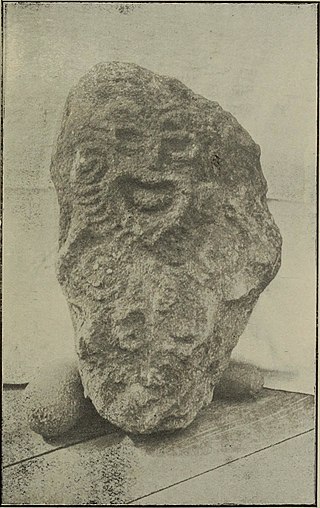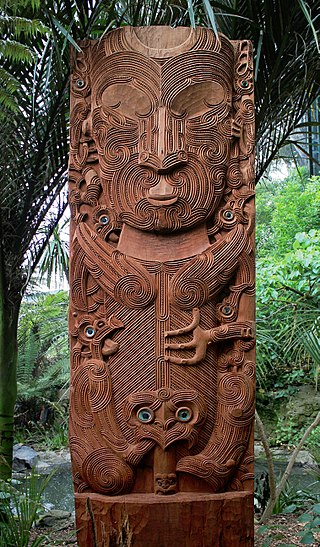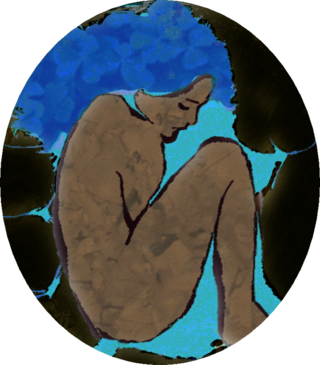
In Māori mythology, Rongo or Rongo-mā-Tāne is a major god (atua) of cultivated plants, especially kumara, a vital crop. Other crops cultivated by Māori in traditional times included taro, yams (uwhi), cordyline (tī), and gourds (hue). Because of their tropical origin, most of these crops were difficult to grow except in the far north of the North Island, hence the importance of Rongo in New Zealand.

In Māori mythology the primal couple Rangi and Papa appear in a creation myth explaining the origin of the world and the Māori people(though there are many different versions). In some South Island dialects, Rangi is called Raki or Rakinui.

In Māori mythology, Tāne is the god of forests and of birds, and the son of Ranginui and Papatūānuku, the sky father and the earth mother, who used to lie in a tight embrace where their many children lived in the darkness between them.

In Māori mythology, Rehua is a very sacred personage, who lives in Te Putahi-nui-o-Rehua in Rangi-tuarea, the tenth and highest of the heavens in some versions of Māori lore. Rehua is identified with certain stars. To the Tūhoe people of the North Island he is Antares. Others say he is Betelgeuse, or Sirius. Because he lives in the highest of the skies, Rehua is untouched by death, and has power to cure blindness, revive the dead, and heal any disease. He is a son of Rangi and Papa, and the father of Kaitangata, as well as the ancestor of Māui. A Ngāi Tahu legend from the South Island speaks of Rehua as the eldest son of Rangi and Papa, who first manifested as lightning, but assumed human shape when he travelled into the skies. Later his brother Tāne went to pay him a visit, Rehua had birds in his hair, feeding on his lice. Rehua had his servants cook and prepare the birds as a meal for Tāne, who was shocked and declined to eat them because the birds had eaten the lice from Rehua's head, which was extremely tapu (sacred). However Rehua gave him birds to bring down to this world, and showed him how to snare them. Tāne also brought with him the fruit trees that the birds fed on, and so it is that there are forests and birds on the earth.
Tangaroa is the great atua of the sea, lakes, rivers, and creatures that live within them, especially fish, in Māori mythology. As Tangaroa-whakamau-tai he exercises control over the tides. He is sometimes depicted as a whale.

In Māori mythology, Tāwhirimātea is the god of weather, including thunder and lightning, wind, clouds and storms. He is a son of Papatūānuku and Ranginui. Tawhirimatea is the second oldest of 7 children, all of whom are boys. In his anger at his brothers for separating their parents, Tāwhirimātea destroyed the forests of Tāne, drove Tangaroa and his progeny into the sea, pursued Rongo and Haumia-tiketike till they had to take refuge in the bosom of their mother Papa, and only found in Tūmatauenga a worthy opponent and eternal enemy. To fight his brothers, Tāwhirimātea gathered an army of his children, winds and clouds of different kinds - including Apū-hau, Apū-matangi, Ao-nui, Ao-roa, Ao-pōuri, Ao-pōtango, Ao-whētuma, Ao-whekere, Ao-kāhiwahiwa, Ao-kānapanapa, Ao-pākinakina, Ao-pakarea, and Ao-tākawe. Grey translates these as 'fierce squalls, whirlwinds, dense clouds, massy clouds, dark clouds, gloomy thick clouds, fiery clouds, clouds which preceded hurricanes, clouds of fiery black, clouds reflecting glowing red light, clouds wildly drifting from all quarters and wildly bursting, clouds of thunder storms, and clouds hurriedly flying on'.
Tūmatauenga is the primary god of war and human activities such as hunting, food cultivation, fishing, and cooking in Māori mythology.
Ao (daylight) is one of the primal deities who are the unborn forces of nature in Māori mythology. Ao is the personification of light, clouds, and the ordinary world, as opposed to darkness and the underworld.
Atea is a deity in several Polynesian cultures, including the Marquesas and Tuamotu Islands, and New Zealand.
In a tradition of the Moriori people of the Chatham Islands, Rohe is the wife of the demi-god Māui. Beautiful Rohe was a sister of the sun, and her face shone. A quarrel arose after Rohe remarked that Māui's face was ugly. Māui then decided that they should change faces.

Avaiki is one of the many names by which the peoples of Polynesia refer to their ancestral and spiritual homelands.
Haumia-tiketike is the god of all uncultivated vegetative food in Māori mythology. He is particularly associated with the starchy rhizome of the Pteridium esculentum, which became a major element of the Māori diet in former times. He contrasts with Rongo, the god of kūmara and all cultivated food plants.
Motoro is a god in Polynesian mythology, the tribal god of the Ngariki of Mangaia. He is the son of Tangiia and the brother of Ruanuku, Kereteki and Utakea. While travelling to Mangaia he argued with his two eldest brothers, was thrown into the sea, and devoured by sharks. His spirit then floated to Mangaia on a piece of hibiscus. He was known as i'o ora because his followers could not be used as human sacrifices.
In Polynesian mythology, Hawaiki is the original home of the Polynesians, before dispersal across Polynesia. It also features as the underworld in many Māori stories.
In Cook Islands mythology of the southern Cook Islands group, the earth goddess Papa was created when Varima-te-takere, the primordial mother goddess, plucked her out from the left side of her body. Papa married her brother, the sky god Vatea. They had twin sons, the sea god Tangaroa and the vegetation god Rongo.

In Cook Islands mythology, Varima-te-takere also called Vari, was the primordial mother of the gods and mortals.

Cook Islands mythology comprises historical myths, legends, and folklore passed down by the ancient Cook Islanders over many generations. Many of the Cook Islands legends were recited through ancient songs and chants. The Cook Islands myths and legends have similarities to general Polynesian mythology, which developed over the centuries into its own unique character.
In Cook Islands mythology, Tumu-te-ana-oa was the female personification of Echo. She was the fourth child of Vari, the primordial mother goddess. Both her name and the land she occupied had to do with the production of echoes. Her name means "the cause (tumu) of the call or voice (oa) heard from caves (ana)". The term oa is used by people when calling out to evoke an echo. Her land was Te Parae-tea, which Gill translates, "The-hollow-gray-rocks". Mamae gives no more detail, but Gill recounts that Tumu-te-ana-oa frequented the caves of Mangaia, where she was seen by Rangi, one of the first inhabitants. The cave in which she was first seen was Aitu-mamaoa.
In Cook Islands mythology, Tango (Support) was the third child of the primordial mother goddess, Varima-te-takere. He was assigned to live at Enua-kura. According to Mamae, Gill's informant, Tango was the progenitor of a skilled fishing family. That the six grandsons of Tango were good workers is shown in the native text. The enclosure (akeke) for fish mentioned in a chant has not been retained in the local culture of the people.
In antiquity, Cook Islanders practiced Cook Islands mythology, before widespread conversion by the London Missionary Society during the nineteenth century. In modern times, the Cook Islands are predominantly Christian, with the largest denomination being the Cook Islands Christian Church.








